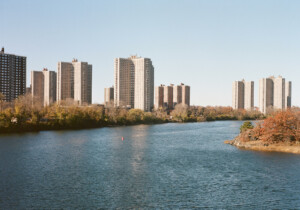The Landmarks Preservation Commission (LPC) was established after the demolition of the old Pennsylvania Station in the early 1960s, with the mission of safeguarding buildings to stabilize property values, foster civic pride, strengthen the city’s economy, protect and enhance the city’s attractions to tourists, and promote the use of these areas for the education, pleasure, and welfare of the people of the city.
Currently, though, it’s safeguarding a parking lot. The LPC’s decision to reject a mixed-income housing proposal on the edge of the patchy South Street Seaport historic district is preventing over 100 families from having affordable $900-to-$1,200 rents in one of the wealthiest parts of our city. The commission is also standing in the way of 2,000 construction jobs during a brutal recession and a $50 million lifeline for the South Street Seaport Museum. Sadly, the LPC’s varied mission has been reinterpreted with a sole emphasis on preserving property values, to the detriment of affordable and integrated housing, and even history itself.

The LPC has gone far beyond their duty to preserve history in the Seaport. The neighborhood’s uniform fabric is not a piece of history, but a modern creation. Walking down Fulton Street into the district, tourists are confronted with mostly modern buildings, with a four-story building from the 1980s (shorter than the five-story ones from the 19th century) to the left and a 35-story skyscraper to the right. On the next block, a squat three-story building from the 1980s sits across the street from a few taller, genuinely historic buildings. While the 19th-century structures that remain are indeed short compared to development from even later that century, the rigidly uniform heights within the historic district are a modern invention of the LPC. Bolstering tourism is indeed among the commission’s fundamental goals, but nobody comes to lower Manhattan looking for a uniform cornice line or a street full of bland, low-rise historicist architecture from the 1980s.
The commissioners—an unelected group of white-collar professionals who probably don’t have neighbors with annual household incomes of $25,000 like mine in the Bronx—could use a history lesson from the Black Gotham Experience walking tour. There, they might learn the deeper and more tortured history than what’s written in the district’s designation report, which mentions the area’s commercial history only as a place where “goods” were traded, starting in 1625 by the Dutch West India Company.
Those “goods” included Black people, who arrived on slave ships that docked in the port and were sold at the Wall Street Slave Market just a few blocks away. They were put to work on ships and throughout the neighborhood, building Broadway, Trinity Church, and the original City Hall. Today, fewer than 3 percent of the area’s approximately 1,000 residents are Black. The very people that served as the foundation for the neighborhood’s wealth are now excluded from it. We cannot preserve a history that excluded the enslaved from our city’s prosperity and now excludes their descendants from its growth.
The city’s administrative code states one of the LPC’s reasons for existence is to “stabilize and improve property values.” Mission accomplished: a 2003 Independent Budget Office study found a statistically significant price premium for properties in historic districts, ranging from 22.6-percent-to-71.8 percent, depending on the year. Higher property values have meant more exclusion—in Manhattan, incomes in historic districts are nearly twice those outside of them.
I can accept the 70 percent of local households who make more than $100,000 claiming that new mixed-income housing “is looking to destroy the integrity of the South Street Seaport Historic District,” using the guise of historic preservation to avoid conceding that they feel preserving their views and property values are higher public priorities than providing opportunities for lower-income families.
What I cannot accept is that an unelected group of officials can block housing and jobs because of their personal aesthetic preferences. The LPC must no longer be able to block housing from being built on vacant or non-historic lots and the final say on land use must reside with the City Council and Mayor. District landmarking—unlike individually designed landmarks—is another tool, like zoning, that our city uses to maintain segregation and protect the equity of property owners. It throws up undue barriers to building new housing of all types and must end.
A group called the Seaport Coalition says “Not only is the South Street Seaport the birthplace of New York City and New York State, but it is also a key piece of America’s national history.” I agree, and much like our country, it was made possible through the contributions of Black people. Black Americans and New Yorkers of all backgrounds who do not earn six figures deserve the opportunity to live there.
John Sanchez is the District Manager of Bronx Community Board 6, and a candidate for City Council in District 15











